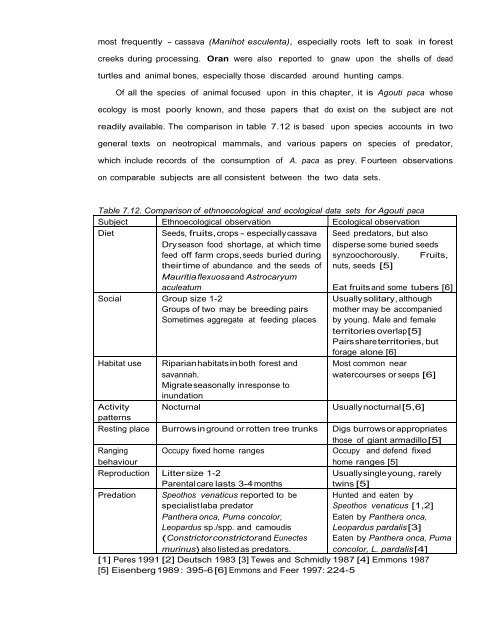Ethnoecology, Resource Use, Conservation And Development In A ...
Ethnoecology, Resource Use, Conservation And Development In A ...
Ethnoecology, Resource Use, Conservation And Development In A ...
You also want an ePaper? Increase the reach of your titles
YUMPU automatically turns print PDFs into web optimized ePapers that Google loves.
most frequently - cassava (Manihot esculenta), especially roots left to soak in forest<br />
creeks during processing. Oran were also reported to gnaw upon the shells of dead<br />
turtles and animal bones, especially those discarded around hunting camps.<br />
Of all the species of animal focused upon in this chapter, it is Agouti paca whose<br />
ecology is most poorly known, and those papers that do exist on the subject are not<br />
readily available. The comparison in table 7.12 is based upon species accounts in two<br />
general texts on neotropical mammals, and various papers on species of predator,<br />
which include records of the consumption of A. paca as prey. Fourteen observations<br />
on comparable subjects are all consistent between the two data sets.<br />
Table 7.12. Comparison of ethnoecological and ecological data sets for Agouti paca<br />
Subject Ethnoecological observation Ecological observation<br />
Diet Seeds, fruits, crops - especially cassava Seed predators, but also<br />
Dry season food shortage, at which time disperse some buried seeds<br />
feed off farm crops, seeds buried during synzoochorously. Fruits,<br />
their time of abundance and the seeds of<br />
Mauritia flexuosa and Astrocaryum<br />
nuts, seeds [5]<br />
aculeatum<br />
Eat fruits and some tubers [6]<br />
Social Group size 1-2<br />
Usually solitary, although<br />
Groups of two may be breeding pairs mother may be accompanied<br />
Sometimes aggregate at feeding places by young. Male and female<br />
territories overlap [5]<br />
Pairs share territories, but<br />
forage alone [6]<br />
Habitat use Riparian habitats in both forest and Most common near<br />
savannah.<br />
Migrate seasonally in response to<br />
inundation<br />
watercourses or seeps [6]<br />
Activity<br />
patterns<br />
Nocturnal Usually nocturnal [5,6]<br />
Resting place Burrows in ground or rotten tree trunks Digs burrows or appropriates<br />
those of giant armadillo [5]<br />
Ranging Occupy fixed home ranges Occupy and defend fixed<br />
behaviour<br />
home ranges [5]<br />
Reproduction Litter size 1-2<br />
Usually single young, rarely<br />
Parental care lasts 3-4 months<br />
twins [5]<br />
Predation Speothos venaticus reported to be Hunted and eaten by<br />
specialist laba predator<br />
Speothos venaticus [1,2]<br />
Panthera onca, Puma concolor,<br />
Eaten by Panthera onca,<br />
Leopardus sp./spp. and camoudis Leopardus pardalis [3]<br />
(Constrictor constrictor and Eunectes Eaten by Panthera onca, Puma<br />
murinus) also listed as predators. concolor, L. pardalis [4]<br />
[1] Peres 1991 [2] Deutsch 1983 [3] Tewes and Schmidly 1987 [4] Emmons 1987<br />
[5] Eisenberg 1989 : 395-6 [6] Emmons and Feer 1997: 224-5


